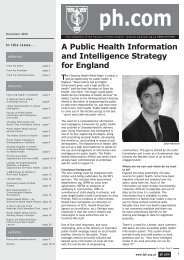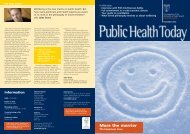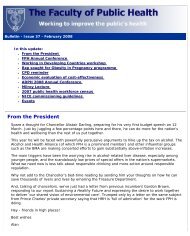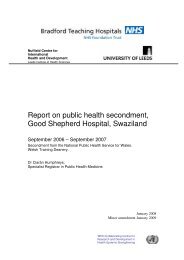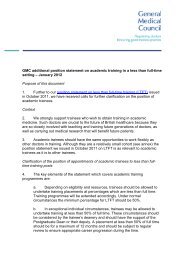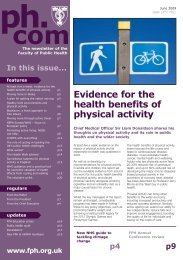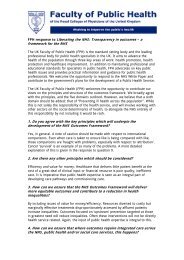A Chronology of State Medicine, Public Health, Welfare and Related ...
A Chronology of State Medicine, Public Health, Welfare and Related ...
A Chronology of State Medicine, Public Health, Welfare and Related ...
You also want an ePaper? Increase the reach of your titles
YUMPU automatically turns print PDFs into web optimized ePapers that Google loves.
1941 Cont - 1942<br />
1941 cont NMcA Gregg (1892-1966) drew attention to congenital defects in children born to<br />
mothers who had had rubella during the pregnancy.<br />
"Poverty <strong>and</strong> Progress", by BS Rowntree, the report <strong>of</strong> the second York survey (see<br />
1901) published.<br />
Introduction <strong>of</strong> purchase tax.<br />
1942 "Social Insurance <strong>and</strong> Allied Services", Cmd.6404, (the "Beveridge Report") by Sir<br />
William Beveridge (1879-1963, later Lord, economist, civil servant, <strong>and</strong> one time director <strong>of</strong><br />
the London School <strong>of</strong> Economics) laid the foundations <strong>of</strong> the post-war welfare state.<br />
"Organisation <strong>of</strong> social insurance should be treated as one part <strong>of</strong> a comprehensive policy <strong>of</strong><br />
social progress. Social insurance fully developed may provide income security; it is an attack<br />
upon Want. But Want is only one <strong>of</strong> five giants on the road <strong>of</strong> reconstruction <strong>and</strong> in some<br />
ways the easiest to attack. The others are Disease, Ignorance, Squalor <strong>and</strong> Idleness. ... Social<br />
security must be achieved by cooperation between the <strong>State</strong> <strong>and</strong> the individual. The <strong>State</strong><br />
should <strong>of</strong>fer security for service <strong>and</strong> contribution. ... The plan proposed here involves three<br />
particular assumptions ... <strong>of</strong> children's allowances, <strong>of</strong> comprehensive health <strong>and</strong> rehabilitation<br />
services, <strong>and</strong> <strong>of</strong> maintenance <strong>of</strong> employment". Beveridge advocated a flat rate <strong>of</strong> subsistence<br />
benefit, flat rate contributions, comprehensiveness, <strong>and</strong> unification <strong>of</strong> administrative<br />
responsibility. See 1945, 1946 <strong>and</strong> 1948.<br />
The reports "L<strong>and</strong> Utilisation in Rural Areas", Cmd.6378, (chairman, Sir Leslie Scott)<br />
<strong>and</strong> "Compensation <strong>and</strong> Betterment", Cmd.6386, (chairman Mr Justice Uthwatt), were<br />
concerned with future rural <strong>and</strong> town planning. See 1943.<br />
The Medical Planning Commission, a body <strong>of</strong> 73 members nominated by 11<br />
organisations including the Royal Colleges <strong>and</strong> the British Medical Association set up in<br />
1940, issued an interim report (Br. Med. J., 1,743-753) suggesting that national health<br />
insurance should be extended to cover 90 per cent <strong>of</strong> the population; that general practitioners<br />
should continue to be paid by capitation fees, but there should be a basic salary <strong>and</strong> fees for<br />
additional work (a minority advocated a salaried service); <strong>and</strong> that they should practise in<br />
groups combining preventive <strong>and</strong> curative care <strong>and</strong> supported by nurses, midwives <strong>and</strong> health<br />
visitors. The report favoured the organisation <strong>of</strong> all hospital, medical <strong>and</strong> allied services on a<br />
regional basis either through a special committee (containing some non-elected members <strong>and</strong><br />
representatives <strong>of</strong> the medical pr<strong>of</strong>ession) <strong>of</strong> new local authorities serving populations <strong>of</strong> not<br />
less than 500,000 resulting from reform <strong>of</strong> local government or through new regional health<br />
councils consisting <strong>of</strong> representatives <strong>of</strong> local authorities within the region <strong>and</strong> containing<br />
representatives <strong>of</strong> the voluntary hospitals <strong>and</strong> <strong>of</strong> the medical pr<strong>of</strong>ession. Grants should be<br />
paid to the voluntary hospitals from Exchequer funds without change <strong>of</strong> ownership <strong>of</strong> the<br />
hospitals. Consultant appointments should be full-time or part-time <strong>and</strong> be salaried, not least<br />
to promote a more even distribution over the country. The central authority should be<br />
concerned "solely" with the civilian health services; it might be a "government department in<br />
the usual sense or it might be a corporate body formed under government auspices <strong>and</strong><br />
responsible through a minister to Parliament". No detailed suggestions were made about the<br />
future <strong>of</strong> the traditional public health services <strong>and</strong> the duties <strong>of</strong> the medical <strong>of</strong>ficers <strong>of</strong> health.<br />
No final report was produced. See 1944.<br />
The Lancet published a report from its Medical Planning Research (Lancet, 2, 599-<br />
622), a group <strong>of</strong> doctors aged under 45 years. The report was intended to present alternative<br />
ideas to those <strong>of</strong> the Medical Planning Commission (see above). The Lancet report urged that<br />
the central authority should be a corporate body (National <strong>Health</strong> Corporation) <strong>and</strong> not a






